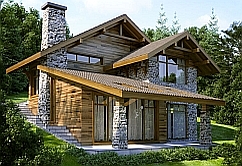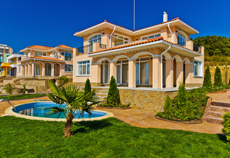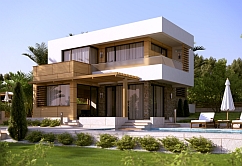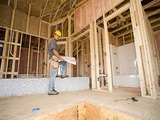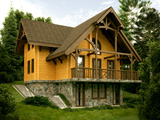What type of service are you looking for?
Boutique Construction and Finishing works
- Construction and development (22)
- Finishing works (23)
- Repair works and reconstruction (29)
- Interior design (16)
- Design (6)
- Landscaping (10)
- Project management (0)
- Green buildings (10)
- Passive houses and buildings
- Prefabricated houses
- Wooden houses
- Economical type of an ecological house
- Alternative sources for heating - geothermal pumps
- Alternative heating sources – solar collectors
- Alternative heating sources - eco pellets
- Alternative sources for generating electrical energy
- Sanitation and isolation
- Geo energy protection
- Children’s playgrounds and sports grounds (2)
- All services and activities
You can build your dream house or villa with us!
Home
Green buildings
Passive houses and buildings
Passive houses and buildings
Construction of passive houses and buildings
Passive houses and passive buildings are those buildings whose interior spaces can be heated and cooled without any active heating or cooling system. The building can heat and cool itself and that is why it is called passive.
The construction of a passive building is to some extent more expensive than the construction of a standard building but in the long term such a building is worth the initial investment because it saves energy from the property’s heating and cooling.
It is believed that passive houses spend around four times less energy than standard houses.
When the costs for designing, building, and installing the specific equipment and the costs for heating, cooling, ventilation and hot water, and electricity in a passive house for a period of 15 years are less then the same costs incurred in a newly-built standard house, the passive house is considered cost effective.
The system for heating and cooling in passive houses is constructed on the basis of air ducts through which fresh air comes in. While passing through the ducts the air is heated or cooled so that it enters the rooms at the desired temperature.
Most often the system that is built is one that supplies fresh air through openings with louvers placed close to the ceiling. The air moves slowly and the fact that the air ducts are placed high means there is no possibility for a draft that could make the inhabitants ill or create any discomfort.
Passive houses and buildings have windows like all standard homes and buildings but it is advisable they be opened only when necessary so that the microclimate in the rooms is not upset. In principle, the cooling and heating system always supplies fresh air which is filtered only to remove the dust and pollen that are part of the environment.
From this point of view passive houses are especially suitable for people with respiratory problems, asthma and allergies. The air in the rooms is cleaner, without dust particles, pollution or pollen.
On very cold days, when one cannot sleep with a window that is even slightly open, the inhabitants of standard homes often wake up with a headache due to the lack of oxygen in the room.
This just shows another of the advantages of the passive homes – during the night there is constant supply of heated fresh air and in the morning the inhabitants wake up rested and refreshed.
The air filters must be changed once a year but this is a simple procedure which the inhabitants can do themselves.
In order for a house or a building to be passive many rules and requirements are observed in its insulation. In practice, all elements of the building are insulated as well as the links between them. The windows must have triple-glass panes as the middle pane is low-emission. The walls, floors and ceilings are also insulated. Most often after the insulation is installed the thickness of the walls reaches and exceeds 30 cm so that the heat transfer standard is reached – less than 0.15 W/m2. The doors are also well insulated and packed from all sides.
With passive houses the annual cost of heating, cooling and ventilation should not exceed in total 15 kWh/sq.m. living area.
On the other hand the cost of the energy used for heating, hot water and electric appliances must not exceed 120 kWh/sq.m. per annum.
Only when all of the abovementioned conditions are met can a house or a building be classified as passive.
The construction of a passive building is to some extent more expensive than the construction of a standard building but in the long term such a building is worth the initial investment because it saves energy from the property’s heating and cooling.
It is believed that passive houses spend around four times less energy than standard houses.
When the costs for designing, building, and installing the specific equipment and the costs for heating, cooling, ventilation and hot water, and electricity in a passive house for a period of 15 years are less then the same costs incurred in a newly-built standard house, the passive house is considered cost effective.
The system for heating and cooling in passive houses is constructed on the basis of air ducts through which fresh air comes in. While passing through the ducts the air is heated or cooled so that it enters the rooms at the desired temperature.
Most often the system that is built is one that supplies fresh air through openings with louvers placed close to the ceiling. The air moves slowly and the fact that the air ducts are placed high means there is no possibility for a draft that could make the inhabitants ill or create any discomfort.
Passive houses and buildings have windows like all standard homes and buildings but it is advisable they be opened only when necessary so that the microclimate in the rooms is not upset. In principle, the cooling and heating system always supplies fresh air which is filtered only to remove the dust and pollen that are part of the environment.
From this point of view passive houses are especially suitable for people with respiratory problems, asthma and allergies. The air in the rooms is cleaner, without dust particles, pollution or pollen.
On very cold days, when one cannot sleep with a window that is even slightly open, the inhabitants of standard homes often wake up with a headache due to the lack of oxygen in the room.
This just shows another of the advantages of the passive homes – during the night there is constant supply of heated fresh air and in the morning the inhabitants wake up rested and refreshed.
The air filters must be changed once a year but this is a simple procedure which the inhabitants can do themselves.
In order for a house or a building to be passive many rules and requirements are observed in its insulation. In practice, all elements of the building are insulated as well as the links between them. The windows must have triple-glass panes as the middle pane is low-emission. The walls, floors and ceilings are also insulated. Most often after the insulation is installed the thickness of the walls reaches and exceeds 30 cm so that the heat transfer standard is reached – less than 0.15 W/m2. The doors are also well insulated and packed from all sides.
With passive houses the annual cost of heating, cooling and ventilation should not exceed in total 15 kWh/sq.m. living area.
On the other hand the cost of the energy used for heating, hot water and electric appliances must not exceed 120 kWh/sq.m. per annum.
Only when all of the abovementioned conditions are met can a house or a building be classified as passive.
Stay in touch with us:
Prefabricated houses
Design, production and installation of prefabricated energy efficient and ecological villas, chalets and houses
Prefabricated houses are especially popular in Western Europe and North America. Their advantage is that they offer a ready solution as the design stage is already done and the client can choose between ready options of prefabricated houses.
The installation of this type of house is considerably easier and faster, as there is no need of technological breaks between the constructions of the different elements.
Prefabricated houses offer a solution in which all insulation is placed in advance in…
View more
Wooden houses
Design and construction of energy efficient and ecological wooden houses
Wooden houses are constructed from wooden logs of a right diameter that are processed in advance. They are assembled as per a special technology so that the wood would make use of its best qualities – extremely good heat and noise insulation, durability and good esthetic appearance.
Wooden houses are ecologically clean and they provide a healthy atmosphere to their inhabitants. The environment is not polluted during the construction of this type of house.
If you wish to own a wooden house that is…
View more
Economical type of an ecological house
Construction of various energy efficient homes and buildings at affordable prices
Our research and our previous experience show that successful composite structures made of reinforced concrete and prefabricated elements do exist.
In this type of construction, the foundations and the first level of the house are built of reinforced concrete. The second level and the next level of the house are usually made of prefabricated construction, including prefabricated roof construction.
In order for this type of composite structure to be applied, a complete construction project needs…
View more
Alternative sources for heating - geothermal pumps
Heating of the buildings with alternative sources of energy - geothermal pumps
The heating through alternative sources of energy is becoming more and more popular during the recent years.
On the market there are many options for building heating and ventilation systems, with the implementation of which the running costs are substantially reduced and the environment remains clean and healthy.
The geothermal pumps are an alternative for heating of buildings during the winter and cooling them during the summer.
The geothermal pumps are most suitable for buildings with…
View more
Alternative heating sources – solar collectors
Heating of buildings with alternative energy sources – solar collectors
On the market there are many options for heating and ventilation of the buildings. With the usage of these alternative heating sources, the running costs are substantially reduced and the environment remains clean and healthy.
The solar panels are among the most popular ways to provide heat and hot water in the buildings. They convert the solar energy into thermal energy which is used in daily life.
The initial investment at the purchase of the solar collectors is relatively big, but it pays in the…
View more






